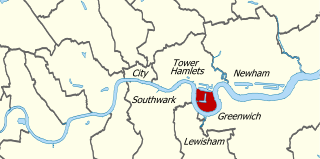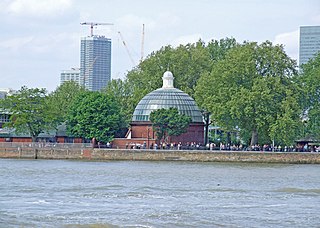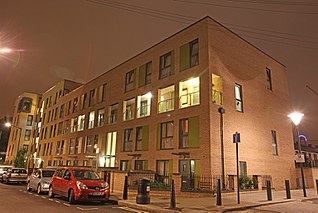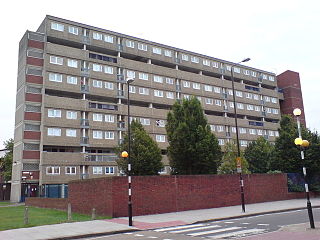
The Isle of Dogs is a large peninsula bounded on three sides by a large meander in the River Thames in East London, England, which includes the Cubitt Town, Millwall and Canary Wharf districts. The area was historically part of the Manor, Hamlet, Parish and, for a time, the wider borough of Poplar. The name had no official status until the 1987 creation of the Isle of Dogs Neighbourhood by Tower Hamlets London Borough Council. It has been known locally as simply "the Island" since the 19th century.

Poplar is a district in East London, England, now part of the London Borough of Tower Hamlets. Five miles (8 km) east of Charing Cross, it is part of the East End.

Poplar was a local government district in the metropolitan area of London, England. It was formed as a district of the Metropolis in 1855 and became a metropolitan borough in the County of London in 1900. It comprised Poplar, Millwall, Bromley-by-Bow and Bow as well as Old Ford, Fish Island and Cubitt Town.

The Lansbury Estate is a large, historic council housing estate in Poplar and Bromley-by-Bow in the London Borough of Tower Hamlets. It is named after George Lansbury, a Poplar councillor and Labour Party MP.

Blackwall is an area of Poplar, in the London Borough of Tower Hamlets, East London. The neighbourhood includes Leamouth and the Coldharbour conservation area.

Millwall is a district on the western and southern side of the Isle of Dogs, in east London, England, in the London Borough of Tower Hamlets. It lies to the immediate south of Canary Wharf and Limehouse, north of Greenwich and Deptford, east of Rotherhithe, west of Cubitt Town, and has a long shoreline along London's Tideway, part of the River Thames. It was part of the County of Middlesex and from 1889 the County of London following the passing of the Local Government Act 1888, it later became part of Greater London in 1965.

North Greenwich is a formal 19th century name for an area now in Millwall situated at the very southern tip of the Isle of Dogs, in the London Borough of Tower Hamlets. It lies to the south of the commercial estates of West India Docks including Canary Wharf and has a short shoreline along London's Tideway part of the River Thames.

Cubitt Town is a district on the eastern side of the Isle of Dogs in London, England. This part of the former Metropolitan Borough of Poplar was redeveloped as part of the Port of London in the 1840s and 1850s by William Cubitt, Lord Mayor of London (1860–1862), after whom it is named. It is on the east of the Isle, facing the Royal Borough of Greenwich across the River Thames. To the west is Millwall, to the east and south is Greenwich, to the northwest Canary Wharf, and to the north — across the Blue Bridge — is Blackwall. The district is situated within the Blackwall & Cubitt Town Ward of Tower Hamlets London Borough Council.

Leamouth is a locality in the Blackwall area of the London Borough of Tower Hamlets. The area takes its name from the former Leamouth Wharf and lies on the west side of the confluence of the Bow Creek stretch of the Lea, at its confluence with the River Thames.

Poplar and Limehouse is a constituency created in 2010 and represented in the House of Commons of the UK Parliament since 2019 by Apsana Begum of the Labour Party. From its creation until 2019, it was represented by Jim Fitzpatrick, also of Labour.

Samuda Brothers was an engineering and ship building firm at Cubitt Town on the Isle of Dogs in London, founded by Jacob and Joseph d'Aguilar Samuda. The site is now occupied by Samuda Estate.

Joseph d'Aguilar Samuda was an English engineer and politician. He was born in London the younger son of Abraham Samuda, and brother of Jacob Samuda. He started out in his father's counting-house, but in 1832 he joined his elder brother to set up Samuda Brothers.

Poplar HARCA is a housing association in the East End of London, England. It is the landlord of about 9,000 homes in the East London area, a quarter of which have been sold leasehold; the remainder are let on assured tenancies at subsidised rent levels.

St John's Estate is a housing scheme in Cubitt Town, on the Isle of Dogs in London. Centred on the triangle formed by Manchester Road, East Ferry Road and Glengall Grove, it was developed by Poplar Borough Council after the Second World War. It is served by Crossharbour DLR station to which it is adjacent.

St Paul's Way Trust School is a comprehensive co-educational all-through school and sixth form located in the Bow Common area of the London Borough of Tower Hamlets, England.
London Yard was a shipyard in London, in use between around 1856 and 1908 by various shipbuilding companies, including Westwood, Baillie and Yarrow Shipbuilders.

J & W Dudgeon was a Victorian shipbuilding and engineering company based in Cubitt Town, London, founded by John and William Dudgeon.

Coldharbour is a street and wider conservation area in Blackwall, lying on the north bank of the River Thames, east of Canary Wharf. The area is said to be "[t]he sole remaining fragment of the old hamlet of Blackwall" and "one of the last examples of the narrow streets which once characterised the river's perimeter".
One Housing Group is a housing association based in London and the south east of the United Kingdom. They manage 16,000 homes and provide support to residents who needs special help, through their social care arm, One Support. As of 2015-16, they had an annual turnover of £255m and employed ~1800 staff.




















